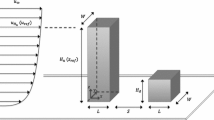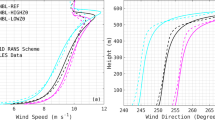Abstract
In many cities, ambient air quality is deteriorating leading to concerns about the health of city inhabitants. In urban areas with narrow streets surrounded by clusters of tall buildings, called street canyons, air pollution from traffic emissions and other sources may accumulate resulting in high pollutant concentrations. For various situations, including the evacuation of populated areas in the event of an accidental or deliberate release of chemical, biological and radiological agents, it is important that models should be developed that produce urban flow fields quickly. Various computational techniques have been used to calculate these flow fields, but these techniques are often computationally intensive. Most fast response models currently in use are at a disadvantage in these cases as they are unable to correlate highly heterogeneous urban structures with the diagnostic parameterizations on which they are based. In this paper, a novel variant of the popular projection method for solving the Navier–Stokes equations has been developed and applied to produce fast and reasonably accurate parallel computational fluid dynamics (CFD) solutions for flow in complex urban areas. This model, called QUIC-CFD represents an intermediate balance between fast (on the order of minutes for a several block problem) and reasonably accurate solutions. This paper details the solution procedure and validates this model for various simple and complex urban geometries.
Similar content being viewed by others
References
Allwine KJ, Leach MJ, Stockham LW, Shinn JS, Hosker RP, Bowers JF, Pace JC (2004) Overview of Joint Urban 2003—an atmospheric dispersion study in Oklahoma City. In: Symposium on planning, nowcasting and forecasting in the urban zone, AMS, Seattle, WA
Anderson JD (1995) Computational fluid dynamics: the basics with applications. McGraw Hill Publishing Company, New York
Brown MJ, Lawson R, Decroix D, Lee R (2001) Mean flow and turbulence measurements around an array of buildings in a wind tunnel. In: 11th AMS conference on applications of air pollution meteorology, Long Beach, CA
Belcher S.E. (2005) Mixing and transport in urban areas. Phil Trans R Soc A 363: 2947–2968
Britter RE, Hanna SR (2003) Flow and dispersion in urban areas. Ann Rev Fluid Mech 35: 469–496
Brown MJ, Boswell D, Streit G, Nelson M, McPherson T, Hilton T, Pardyjak ER, Pol S, Ramamurthy P, Hansen B, Kastner-Klein P, Clark J, Moore A, Felton N, Strickland D, Brook D, Princevac M, Zajic D, Wayson R, MacDonald J, Fleming G, Storwold D (2004) Joint urban 2003 street canyon experiment. In: Symposium on planning, nowcasting and forecasting in the urban zone, AMS, Seattle, WA
Camelli F, Coirier WJ, Hansen OR, Huber A, Kim S, Hanna S, Brown M (2006) An intercomparison of four computational fluid dynamics models: transport and dispersion around Madison square garden. American Meteorological Society. In: 6th Symposium on the urban environment, Atlanta, GA
Castro IP, Robins AG (1977) The flow around a surface-mounted cube in uniform and turbulent streams. J Fluid Mech 79: 307–335
Choi D, Merkle CL (1985) Application of time-iterative schemes to incompressible flow. AIAA J 23: 1518–1524
Chorin AJ (1968) Numerical solution of the Navier–Stokes equations. Math Comput 22: 745–762
Clawson KL, Carter RG, Lacroix DJ, Biltoft CA, Hukari NF, Johnson RC, Rich JD (2005) Joint urban 2003 (JU03) SF6 atmospheric tracer field tests. NOAA Technical Memorandum OARARL-254, Air Resources Lab
Coirier WJ, Kim S (2006) Summary of CFD urban results in support of the Madison square garden and urban dispersion program field tests. In: 6th symposium on the urban environment. American Meteorological Society, Atlanta, GA
Coirier WJ, Kim S, Chen F, Tuwari M (2006) Evaluation of urban scale contaminant transport and dispersion modeling using loosely coupled CFD and mesoscale models. In: 6th symposium on the urban environment. American Meteorological Society, Atlanta, GA
Dabberdt W, Ludwig F, Johnson W (1973) Validation and applications of an urban diffusion model for vehicular pollutants. Atmos Environ 7: 603–618
Diehl SR, Burrows DA, Hendricks EA, Keith R (2006) Urban dispersion modeling: comparison with single-building measurements. J Appl Meteorol Clim 46: 2180–2191
Driver DM (1991) Reynolds shear stress measurements in a separated boundary layer. In: 22nd AIAA fluid dynamics, plasma dynamics and lasers conference, Honolulu, HI
Ferziger JH, Peric M (2002) Computational methods for fluid dynamics, 3rd edn. Springer, Berlin
Flaherty J, Allwine KJ, Allwine E (2007) Vertical tracer concentration profiles measured during the joint urban 2003 dispersion study. J Appl Meteorol Clim 46: 2019–2037
Fortin M, Peyret R, Temam R (1971) Résolution numérique des équations de Navier–Stokes pour un fluide incompressible. J Mécanique 10: 357–390
Gowardhan AA, Brown MJ, Pardyjak ER (2010) Evaluation of a fast response pressure solver for flow around an isolated cube. Environ Fluid Mech 10: 311–328. doi:10.1007/s10652-009-9152-5
Hall DJ, Sharples H, Walker S, Kukadia V (2000) Attribution of pollutant concentrations on buildings from local traffic—effects on ventilation requirements. BRE Client Report 81461
Hotchkiss RS, Harlow FH (1973) Air pollution in street canyons. EPA-R4-73-029
Irwin JS (1978) A theoretical variation of the wind profile power law exponent as a function of surface roughness and stability. Atmos Environ 13: 191–194
Kanda M (2007) Progress in urban meteorology: a review. J Meteorol Soc Jpn 85: 363–383
Kaplan H, Dinar N (1996) A Lagrangian dispersion model for calculating concentration distribution within a built-up domain. Atmos Environ 30: 4197–4207
Kim J, Moin P (1986) Application of a fractional-step method to incompressible Navier–Stokes. J Comput Phys 59: 308–323
Klein P, Leitl B, Schatzmann M (2007) Driving physical mechanisms of flow and dispersion in urban canopies. Int J Clim 27: 1887–1907
Kwak D, Chang JLC, Shanks SP, Chakravarthy SR (1986) A three-dimensional incompressible Navier–Stokes flow solver using primitive variables. AIAA J 24: 390–396
Ladevéze J, Peyret R (1974) Calcul numérique d’une solution avec singularité des équations de Navier–Stokes: écoulement dans un canal avec variation brusque de section. J Mécanique 13: 367–396
Merkle CL, Athavale M (1987) Time-accurate unsteady incompressible flow algorithms based on artificial compressibility. In: 8th AIAA computational fluid dynamics conference, AIAA-1987-1137, Honolulu, Hawaii
Nelson MA, Pardyjak ER, Klewicki JC, Pol SU, Brown MJ (2007) Properties of the wind field within the Oklahoma City Park Avenue street canyon. Part I: Mean flow and turbulence statistics. J Appl Meteorol 46: 2038–2054
Neophytou M, Gowardhan A, Brown M (2010) An inter-comparison of three urban wind models using Oklahoma City Joint Urban 2003 wind field measurements, submitted to the J Wind Eng Indus Aerodyn. doi:10.1016/j.jweia.2011.01.010
Oke TR (1987) Street design and urban canopy layer climate. Energy and Buildings 11: 103–113
OpenMP Fortran/C Application Program Interface, http://www.openmp.org/
Pardyjak ER, Brown MJ (2001) Evaluation of a fast-response urban wind model-comparison to single-building wind-tunnel data. Los Alamos National Laboratory report LA-UR-01-4028
Patankar SV (1980) Numerical heat transfer and fluid flow. McGraw Hill, New York
Patnaik G, Boris JP, Grinstein FF, Iselin JP (2003) Large scale urban simulations with the MILES approach. In: Annual AIAA CFD conference, AIAA paper 2003-4104, Orlando, FL
Peyret R, Taylor TD (1983) Computational methods for fluid flow. Springer, Berlin
Pletcher RH, Chen K (1993) On solving the compressible Navier–Stokes equations for unsteady flows at very low Mach numbers. AIAA Paper 93-3368
Pope SB (2000) Turbulent flows. Cambridge University Press, Cambridge
Prandtl L (1926) Application of the “Magnus effect” to the wind propulsion of ships. NACA TM 387
Röckle R (1990) Bestimmung der stomungsverhaltnisse im Bereich Komplexer Bebauugsstrukturen. Ph.D. thesis, Vom Fachbereich Mechanik, der Technischen Hochschule Darmstadt, Germany
Schulman L, Strimaitis D, Scire J (2000) Development and evaluation of the PRIME plume rise and building downwash model. J Air & Waste Manage Assoc 50: 378–390
Singh B, Hansen B, Brown MJ, Pardyjak ER (2008) Evaluation of the QUIC-URB fast response urban wind Model for a cubical building array and wide building street canyon. Environ Fluid Mech 8: 281–312
Snyder WH (1979) The EPA meteorological wind tunnel: its design, construction, and operating characteristics. EPA-600/4-79-051, Environmental Protection Agency, Res Tri Pk, NC
Snyder WH, Lawson RE (1994) Wind-tunnel measurements of flow fields in the vicinity of buildings. In: 8th joint conference on application of air pollution meteorology with AWMA. American Meteorological Society, Nashville, TN
Taulbee DB, Tran L (1988) Stagnation streamline turbulence. AIAA J 26: 1011–1013
Theurer W, Baechlin W, Plate E (1992) Model study of the development of boundary layers above urban areas. In: 8th joint conference on application of air pollution Meteorology with AWMA. American Meteorological Society, Nashville, TN
Viecelli JA (1971) A computing method for incompressible flows bounded by moving walls. J Comput Phys 9: 119–143
Warner S, Platt N, Heagy JF, Jordan JE, Bieberbach G (2006) Comparisons of transport and dispersion model predictions of the mock urban setting test field experiment. J Appl Meteorol 45: 1414–1428
Wilcox DC (1993) Turbulence modeling for CFD. DCW Industries Inc, La Canada, CA
Yakhot A, Liu HP, Nikitin N (2006) Turbulent flow around a wall-mounted cube: a direct numerical simulation. Intl J Heat Fluid Flow 27: 994–1009
Yamartino R, Strimaitis D, Messier T (1989) Modification of highway air pollution models for complex site geometries. Data analyses and development of the CPB-3 model, vol 1. Rep No FHWA-RD-89-112
Author information
Authors and Affiliations
Corresponding author
Rights and permissions
About this article
Cite this article
Gowardhan, A.A., Pardyjak, E.R., Senocak, I. et al. A CFD-based wind solver for an urban fast response transport and dispersion model. Environ Fluid Mech 11, 439–464 (2011). https://doi.org/10.1007/s10652-011-9211-6
Received:
Accepted:
Published:
Issue Date:
DOI: https://doi.org/10.1007/s10652-011-9211-6




